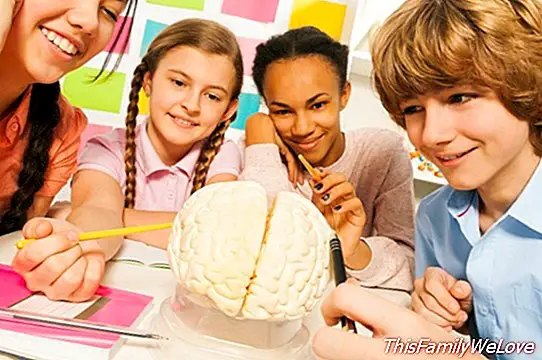The brain of the child: how to tune in with its two hemispheres?

Knowing the neurobiological bases that govern the functioning of the mind, allows us to promote and promote brain processes. Thanks to advances in neuroscience we have been able to glimpse the ins and outs of our minds. Know how it is and how it works the child's brain it opens a wide range of possibilities, and can help us to optimize our educational work, since it allows us to enhance learning.
How is the child's brain?
1. A developing brain
The brain of the child it is first and foremost a brain in development. The first two years of life, constitute the stage of maximum neuronal plasticity, that is, it is in these first moments when most of the neural connections that are the basis of learning and skills are created.
2. The brain of the two hemispheres
The brain It is formed by two symmetrical cerebral hemispheres, the right and the left. The left hemisphere It is in charge of the movements of the right part of the body and it is also the rational, logical and verbal part. On the other hand the right hemisphere It is responsible for the movements of the left part of the body and the emotional and artistic part. The left hemisphere is logical and verbal, does linear and logical reasoning, instead the right hemisphere is emotional and creative, makes holistic, nonlinear reasoning, looking for different solutions. Children, in a first stage of development, have not clearly defined laterality and therefore, there is no hemisphere that clearly dominates.
The adult brain and the child's brain
The brain of an adult person usually governed by the dominance of the left hemisphereor, the rational and the brain of the childAlthough it has not yet defined its dominance, it is a predominantly emotional brain, sensorial and emotive. For that reason, in many occasions we have important difficulties to tune into the brain of the child because we do it from our rational brain and they still have not reached the level of development that allows them to understand at the level of an adult reasoning.
Steps to tune into the child's brain
The The child's brain is a brain sensitive to learning, development and emotional experience. Through the experiences and experiences of the child will be shaping his brain, will be establishing connections between neurons and configuring the dominance. The work of the family and the educators is very important, since we can choose the experiences we provide to the children and try to make these experiences a stimulus for their development.
1. Begin to listen with our emotional part, not only with the rational part. Be careful, it is not about going to the opposite side and using only the emotional part, leaving aside the rational part. It is a matter of combining both parts of using our brain in an integrated way, and favoring that children can also integrate the two parts of their mind.
2. Practice active listening to tune in through the emotional part. It consists of going beyond what he tells us, of making an active listening to understand the emotion of the child. Remember that when you complain or misbehave, you have a hard time rationally understanding what you are doing wrong, and your behavior is the result of an emotion.
3. Show empathy. Try to recognize the emotion that you have, what is happening to you (anger? Fear ?, shame ?, etc.) and shows empathy ("I understand", "it is normal that *." Make him see that you understand him , that will relax them and help them manage their emotion.
4. Balances the rational and the emotional part. Just after that, enter the rational part, adapted to your level ("but doing * does not work for you", "because not * ..."). It is about reaching emotion and guiding the child from the emotion, allowing him to integrate with his rational part.
5. Try to stimulate the child, and encourage the creation of connections, but beware of over-stimulating. Avoid pressing.
Celia Rodríguez Ruiz. Clinical health psychologist. Specialist in pedagogy and child and youth psychology. Director of Educa and Learn. Author of the collection Stimulate Reading and Writing Processes.




